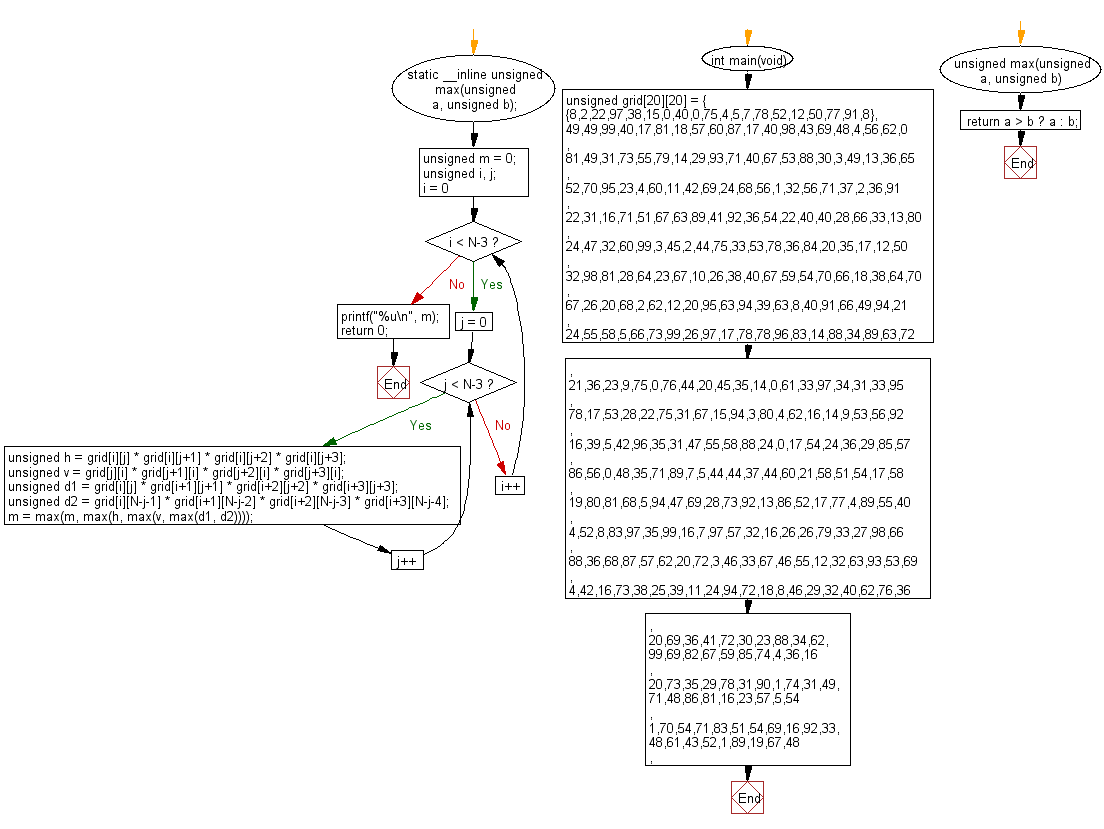C Exercises: Find the first missing positive integer from a given unsorted integer array
C Programming Practice: Exercise-27 with Solution
In the 20×20 grid below, four numbers along a diagonal line have been marked in red.
08 02 22 97 38 15 00 40 00 75 04 05 07 78 52 12 50 77 91 08
49 49 99 40 17 81 18 57 60 87 17 40 98 43 69 48 04 56 62 00
81 49 31 73 55 79 14 29 93 71 40 67 53 88 30 03 49 13 36 65
52 70 95 23 04 60 11 42 69 24 68 56 01 32 56 71 37 02 36 91
22 31 16 71 51 67 63 89 41 92 36 54 22 40 40 28 66 33 13 80
24 47 32 60 99 03 45 02 44 75 33 53 78 36 84 20 35 17 12 50
32 98 81 28 64 23 67 10 26 38 40 67 59 54 70 66 18 38 64 70
67 26 20 68 02 62 12 20 95 63 94 39 63 08 40 91 66 49 94 21
24 55 58 05 66 73 99 26 97 17 78 78 96 83 14 88 34 89 63 72
21 36 23 09 75 00 76 44 20 45 35 14 00 61 33 97 34 31 33 95
78 17 53 28 22 75 31 67 15 94 03 80 04 62 16 14 09 53 56 92
16 39 05 42 96 35 31 47 55 58 88 24 00 17 54 24 36 29 85 57
86 56 00 48 35 71 89 07 05 44 44 37 44 60 21 58 51 54 17 58
19 80 81 68 05 94 47 69 28 73 92 13 86 52 17 77 04 89 55 40
04 52 08 83 97 35 99 16 07 97 57 32 16 26 26 79 33 27 98 66
88 36 68 87 57 62 20 72 03 46 33 67 46 55 12 32 63 93 53 69
04 42 16 73 38 25 39 11 24 94 72 18 08 46 29 32 40 62 76 36
20 69 36 41 72 30 23 88 34 62 99 69 82 67 59 85 74 04 36 16
20 73 35 29 78 31 90 01 74 31 49 71 48 86 81 16 23 57 05 54
01 70 54 71 83 51 54 69 16 92 33 48 61 43 52 01 89 19 67 48
The product of these numbers is 26 × 63 × 78 × 14 = 1788696.
Write a C programming to find the greatest product of four adjacent numbers in the same direction (up, down, left, right, or diagonally) in the 20×20 grid.
C Code:
// (c) 2009, eagletmt MIT License <http://opensource.org/licenses/mit-license.php>
#include <stdio.h>
#define N 20
static __inline unsigned max(unsigned a, unsigned b);
int main(void)
{
unsigned grid[20][20] = {
{8,2,22,97,38,15,0,40,0,75,4,5,7,78,52,12,50,77,91,8},
{49,49,99,40,17,81,18,57,60,87,17,40,98,43,69,48,4,56,62,0},
{81,49,31,73,55,79,14,29,93,71,40,67,53,88,30,3,49,13,36,65},
{52,70,95,23,4,60,11,42,69,24,68,56,1,32,56,71,37,2,36,91},
{22,31,16,71,51,67,63,89,41,92,36,54,22,40,40,28,66,33,13,80},
{24,47,32,60,99,3,45,2,44,75,33,53,78,36,84,20,35,17,12,50},
{32,98,81,28,64,23,67,10,26,38,40,67,59,54,70,66,18,38,64,70},
{67,26,20,68,2,62,12,20,95,63,94,39,63,8,40,91,66,49,94,21},
{24,55,58,5,66,73,99,26,97,17,78,78,96,83,14,88,34,89,63,72},
{21,36,23,9,75,0,76,44,20,45,35,14,0,61,33,97,34,31,33,95},
{78,17,53,28,22,75,31,67,15,94,3,80,4,62,16,14,9,53,56,92},
{16,39,5,42,96,35,31,47,55,58,88,24,0,17,54,24,36,29,85,57},
{86,56,0,48,35,71,89,7,5,44,44,37,44,60,21,58,51,54,17,58},
{19,80,81,68,5,94,47,69,28,73,92,13,86,52,17,77,4,89,55,40},
{4,52,8,83,97,35,99,16,7,97,57,32,16,26,26,79,33,27,98,66},
{88,36,68,87,57,62,20,72,3,46,33,67,46,55,12,32,63,93,53,69},
{4,42,16,73,38,25,39,11,24,94,72,18,8,46,29,32,40,62,76,36},
{20,69,36,41,72,30,23,88,34,62,99,69,82,67,59,85,74,4,36,16},
{20,73,35,29,78,31,90,1,74,31,49,71,48,86,81,16,23,57,5,54},
{1,70,54,71,83,51,54,69,16,92,33,48,61,43,52,1,89,19,67,48},
};
unsigned m = 0;
unsigned i, j;
for (i = 0; i < N-3; i++) {
for (j = 0; j < N-3; j++) {
unsigned h = grid[i][j] * grid[i][j+1] * grid[i][j+2] * grid[i][j+3];
unsigned v = grid[j][i] * grid[j+1][i] * grid[j+2][i] * grid[j+3][i];
unsigned d1 = grid[i][j] * grid[i+1][j+1] * grid[i+2][j+2] * grid[i+3][j+3];
unsigned d2 = grid[i][N-j-1] * grid[i+1][N-j-2] * grid[i+2][N-j-3] * grid[i+3][N-j-4];
m = max(m, max(h, max(v, max(d1, d2))));
}
}
printf("%u\n", m);
return 0;
}
unsigned max(unsigned a, unsigned b)
{
return a > b ? a : b;
}
Sample Output:
70600674
Flowchart:

C Programming Code Editor:
Contribute your code and comments through Disqus.
Previous: Write a C programming to find the sum of all the primes below ten thousand.
Next: Write a C programming to find the sum of the even-valued terms from the terms in the Fibonacci sequence whose values do not exceed one million.
What is the difficulty level of this exercise?
C Programming: Tips of the Day
C Programming - Why do all the C files written by my lecturer start with a single # on the first line?
In the very early days of pre-standardised C, if you wanted to invoke the preprocessor, then you had to write a # as the first thing in the first line of a source file. Writing only a # at the top of the file affords flexibility in the placement of the other preprocessor directives.
From an original C draft by the great Dennis Ritchie himself:
12. Compiler control lines
[...] In order to cause [the] preprocessor to be invoked, it is necessary that the very first line of the program begin with #. Since null lines are ignored by the preprocessor, this line need contain no other information.
That document makes for great reading (and allowed me to jump on this question like a mad cat).
I suspect it's the lecturer simply being sentimental - it hasn't been required certainly since ANSI C.
Ref : https://bit.ly/2Mb8OVZ
- New Content published on w3resource:
- Scala Programming Exercises, Practice, Solution
- Python Itertools exercises
- Python Numpy exercises
- Python GeoPy Package exercises
- Python Pandas exercises
- Python nltk exercises
- Python BeautifulSoup exercises
- Form Template
- Composer - PHP Package Manager
- PHPUnit - PHP Testing
- Laravel - PHP Framework
- Angular - JavaScript Framework
- React - JavaScript Library
- Vue - JavaScript Framework
- Jest - JavaScript Testing Framework
